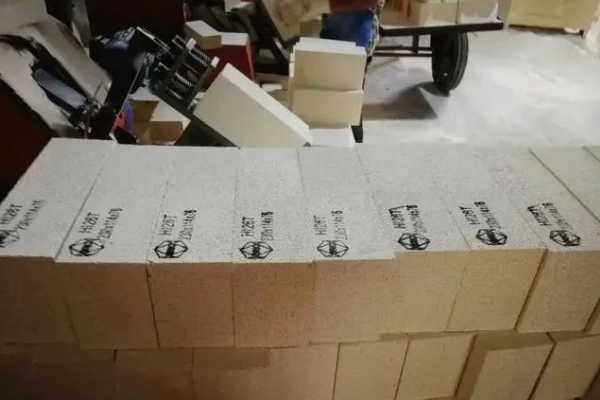
The classification of lightweight refractories can be divided according to their chemical composition, use temperature, the existence of different forms, and microstructure.
Lightweight refractories are refractories with low thermal conductivity and low heat capacity, also known as insulating refractories.
Lightweight refractories are generally characterized by high porosity and low bulk density and are often referred to as thermal insulating refractories.
Traditionally, lightweight refractories have poor erosion resistance, قوة, and abrasion resistance, so they are generally not used directly as work surface materials, but are placed behind the work surface as an insulating layer. لكن, the closer the lightweight refractory material is to the working face, the better its thermal insulation effect.
With the improvement of energy saving and emission reduction requirements, the development and research of lightweight refractory materials with high strength, مقاومة درجات الحرارة العالية, ومقاومة التآكل, which can be used directly in the working face, have been widely emphasized.
The classification of lightweight refractories can be divided according to their chemical composition, use temperature, the existence of different forms, and microstructure.
According to the different chemical mineral compositions, lightweight refractories can be divided into alumina lightweight refractory materials, high alumina lightweight refractory materials, mullite lightweight refractory materials, silica lightweight refractory materials, clay lightweight refractory materials, vermiculite lightweight refractory materials and diatomaceous earth lightweight refractory materials.
Lightweight refractories can also be divided according to the use of temperature, the use of lightweight refractories is the temperature at which the re-firing shrinkage is not greater than 1% إلى 2%.
According to the use of temperature division, lightweight refractories can be divided into low-temperature lightweight refractories (use temperature <600 ℃), medium-temperature lightweight refractories (use temperature 600 ~ 1200 ℃), and high-temperature lightweight refractories (use temperature > 1200 ℃). High-temperature lightweight refractories are the most commonly used heat-insulating materials in industrial kilns.
According to the existence of the form of division, lightweight refractories can be divided into powder granular, شكل, fiber, and composite lightweight refractories.
فضلاً عن ذلك, according to the structural characteristics, lightweight refractories can also be divided into gas-phase continuous structural type, solid-phase continuous structural type, and solid-phase and gas-phase continuous structural type.
Lightweight refractories are prepared by the basic principle of reducing the thermal conductivity of the material.
Since lightweight refractories contain many voids, the form of heat transfer through lightweight refractories is the solid phase and gas phase heat transfer.
Solid-phase form of heat transfer is mainly conduction, while a gas-phase form of heat transfer is more complex: heat from the high-temperature zone to the internal process of insulation materials, in the process of touching the air holes before the role of heat conduction is occurring in the solid phase.
After encountering the pores, the heat transfer pathway becomes two and continues to transfer through the solid phase and the pores. For the part of heat transfer that continues through the solid phase, the distance of the heat transfer route is greatly increased due to the change in the direction of conduction, أي., the thermal resistance becomes larger.
The heat transferred through the stomata is conduction through the gas, convection heat transfer, and radiation heat transfer.
(1) Heat conduction: عادة, the thermal conductivity of the gas is very small, and most of the gas in the internal pores of lightweight refractory materials is air. The thermal conductivity of air is much smaller than that of solid materials. لذلك, the heat conducted through the pores is very little.
(2) Convective heat transfer: convective heat transfer occurs mainly through the flow of gas. As most of the lightweight refractories in the pore are very small, air flow in the pore will be greatly restricted, and the gas flow rate is very small, so the heat transfer is also very small.
The smaller the aperture of the pore, the less fluidity of the air in the pore, and the smaller the amount of liquid transferred by convection.
When the aperture of the pore is smaller than the pore of gas molecules in the movement of the free range, the gas molecules stop moving, there is no longer heat through the gas convection transfer.
(3) radiation heat transfer: because most of the lightweight refractory pore gas for the air, and gas molecules are mostly N2 and O2. they are symmetric double-atom type molecular structures.
This kind of gas molecules absorb and emit radiation ability is relatively poor.
لذلك, the radiation heat transfer through the pore is mainly through the high-temperature wall of the pore to the low-temperature wall for radiation. But in general, the radiation heat transfer through the pores is not very large.
It can be seen that the existence of pores on the ability of lightweight refractory heat insulation is a great help, in many cases, the design of heat insulation materials is centered on the introduction of pores to carry out.
منذ أكتوبر, استمرت أسعار الألومينا في الارتفاع, and China's largest bauxite importer - a…
أولاً, ارتفاع طوب الألومينا: The Leader In High Temperature Refractories As a leader in high-temperature…
The application of refractory bricks in the kiln immediately endangers the operation rate of the…
Analysis Of The Causes Of Common Quality Problems In Tunnel Kiln Construction And Measures To…
Corundum quality refractory castables are made from corundum to the new jade refractory insulation material…
تحليل المواد الخام المقاومة للحرارة من الألومنيوم والسيليكون البروفيسور. Li Yong of the University of Science and…